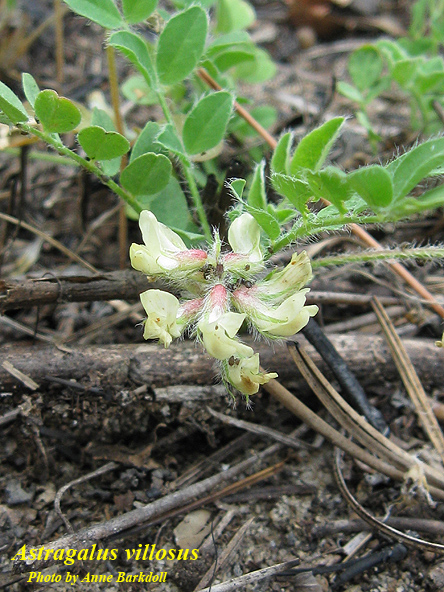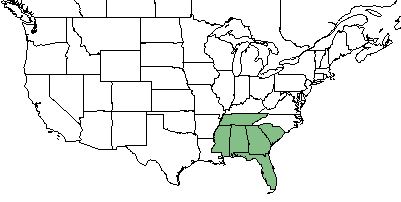Difference between revisions of "Astragalus villosus"
HaleighJoM (talk | contribs) (→Ecology) |
|||
| (9 intermediate revisions by 6 users not shown) | |||
| Line 1: | Line 1: | ||
{{italic title}} | {{italic title}} | ||
| − | Common name: | + | Common name: Bearded Milkvetch; Southern Milkvetch |
<!-- Get the taxonomy information from the NRCS Plants database --> | <!-- Get the taxonomy information from the NRCS Plants database --> | ||
{{taxobox | {{taxobox | ||
| Line 19: | Line 19: | ||
}} | }} | ||
==Taxonomic Notes== | ==Taxonomic Notes== | ||
| − | Synonyms: ''Phaca intonsa'' (Sheldon) Rydberg ex Small | + | Synonyms: ''Phaca intonsa'' (Sheldon) Rydberg ex Small.<ref name="weakley">Weakley, A.S. 2015. Flora of the southern and mid-atlantic states. Working Draft of 21 May 2015. University of North Carolina at Chapel Hill, Chapel Hill, North Carolina.</ref> |
| − | Varieties: none | + | Varieties: none.<ref name="weakley">Weakley, A.S. 2015. Flora of the southern and mid-atlantic states. Working Draft of 21 May 2015. University of North Carolina at Chapel Hill, Chapel Hill, North Carolina.</ref> |
==Description== | ==Description== | ||
<!-- Basic life history facts such as annual/perrenial, monoecious/dioecious, root morphology, seed type, etc. --> | <!-- Basic life history facts such as annual/perrenial, monoecious/dioecious, root morphology, seed type, etc. --> | ||
| − | ''A. villosus'' is an annual forb/herb of the ''Fabaceae'' family native to North America. <ref name= "USDA Plant Database"> USDA Plant Database [https://plants.usda.gov/core/profile?symbol=ASVI6 https://plants.usda.gov/core/profile?symbol=ASVI6] </ref> | + | ''A. villosus'' is an annual forb/herb of the ''Fabaceae'' family native to North America. <ref name= "USDA Plant Database"> USDA Plant Database [https://plants.usda.gov/core/profile?symbol=ASVI6 https://plants.usda.gov/core/profile?symbol=ASVI6] </ref> It has a growth form that is low-growing and spreading.<ref name= "Lady bird">[[https://www.wildflower.org/plants/search.php?search_field=&newsearch=true]] Lady Bird Johnson Wildflower Center. Accessed: March 25, 2019</ref> |
==Distribution== | ==Distribution== | ||
| Line 32: | Line 32: | ||
==Ecology== | ==Ecology== | ||
===Habitat=== <!--Natural communities, human disturbed habitats, topography, hydrology, soils, light, fire regime requirements for removal of competition, etc.--> | ===Habitat=== <!--Natural communities, human disturbed habitats, topography, hydrology, soils, light, fire regime requirements for removal of competition, etc.--> | ||
| − | ''A. villosus'' proliferates in sandhills and other loose, dry, sandy places. <ref name= "Weakley 2015"> Weakley, A. S. (2015). Flora of the Southern and Mid-Atlantic States. Chapel Hill, NC, University of North Carolina Herbarium. </ref> It can also be found in clay soils. <ref name= "FSU | + | ''A. villosus'' proliferates in sandhills and other loose, dry, sandy places. <ref name= "Weakley 2015"> Weakley, A. S. (2015). Flora of the Southern and Mid-Atlantic States. Chapel Hill, NC, University of North Carolina Herbarium. </ref> It can also be found in clay soils, loose sand, loamy sand, pinewoods, old field, and burned pineland.<ref name = "FSU herbarium"> URL: http://herbarium.bio.fsu.edu. Last accessed: June 2018. Collectors: Loran C. Anderson, R.K. Godfrey, J.B. Nelson, Brenda Herring, Don Herring, R.Kral, M. Knott, LB Trott, Richard D. Houk, Delzie Demaree, D. Burch, George Cooley, Joseph Monachino, Rodie White, James W. Hardin, Wilbur H. Duncan, Ron Miller, Jim Lytton, Rod Wilson. States and counties: Florida (Leon, Wakulla, Franklin, Taylor, Santa Rosa, Escambia, Walton, Liberty, Madison, Lafayette, Lake, Columbie, Hernando, Gilchrist, Citrus, Clay) Georgia (Grady, Thomas) Alabama (Escambia)</ref> |
| − | ===Phenology=== <!--Timing off flowering, fruiting | + | ===Phenology=== <!--Timing off flowering, fruiting, and environmental triggers. Cite PanFlora website if appropriate: http://www.gilnelson.com/PanFlora/ --> |
| − | ''A. villosus'' | + | ''A. villosus'' has been observed flowering between February and April. <ref name= "PanFlora"> Nelson, G. PanFlora: Plant data for the eastern United States with emphasis on the Southeastern Coastal Plains, Florida, and the Florida Panhandle. www.gilnelson.com/PanFlora/ Accessed: 17 MAY 2018 </ref> |
<!--===Seed dispersal===--> | <!--===Seed dispersal===--> | ||
<!--===Seed bank and germination===--> | <!--===Seed bank and germination===--> | ||
<!--===Fire ecology===--> <!--Fire tolerance, fire dependence, adaptive fire responses--> | <!--===Fire ecology===--> <!--Fire tolerance, fire dependence, adaptive fire responses--> | ||
| − | <!--===Pollination | + | <!--===Pollination==--> |
| − | <!--=== | + | <!--===Herbivory and toxicology===--><!--Herbivory, granivory, insect hosting, etc.--> |
<!--==Diseases and parasites==--> | <!--==Diseases and parasites==--> | ||
| − | ==Conservation and | + | ==Conservation, cultivation, and restoration== |
| − | == | + | ==Cultural use== |
==Photo Gallery== | ==Photo Gallery== | ||
<gallery widths=180px> | <gallery widths=180px> | ||
</gallery> | </gallery> | ||
==References and notes== | ==References and notes== | ||
Latest revision as of 19:30, 15 June 2022
Common name: Bearded Milkvetch; Southern Milkvetch
| Astragalus villosus | |
|---|---|

| |
| Photo by the Atlas of Florida Plants Database | |
| Scientific classification | |
| Kingdom: | Plantae |
| Division: | Magnoliophyta - Flowering plants |
| Class: | Magnoliopsida - Dicots |
| Order: | Fabales |
| Family: | Fabaceae |
| Genus: | Astragalus |
| Species: | A. villosus |
| Binomial name | |
| Astragalus villosus Michx. | |

| |
| Natural range of Astragalus villosus from USDA NRCS Plants Database. | |
Contents
Taxonomic Notes
Synonyms: Phaca intonsa (Sheldon) Rydberg ex Small.[1]
Varieties: none.[1]
Description
A. villosus is an annual forb/herb of the Fabaceae family native to North America. [2] It has a growth form that is low-growing and spreading.[3]
Distribution
A. villosus is found in the southeastern corner of the United States, specifically in Tennessee, Mississippi, Alabama, Georgia, South Carolina, and Florida. [2]
Ecology
Habitat
A. villosus proliferates in sandhills and other loose, dry, sandy places. [4] It can also be found in clay soils, loose sand, loamy sand, pinewoods, old field, and burned pineland.[5]
Phenology
A. villosus has been observed flowering between February and April. [6]
Conservation, cultivation, and restoration
Cultural use
Photo Gallery
References and notes
- ↑ 1.0 1.1 Weakley, A.S. 2015. Flora of the southern and mid-atlantic states. Working Draft of 21 May 2015. University of North Carolina at Chapel Hill, Chapel Hill, North Carolina.
- ↑ 2.0 2.1 USDA Plant Database https://plants.usda.gov/core/profile?symbol=ASVI6
- ↑ [[1]] Lady Bird Johnson Wildflower Center. Accessed: March 25, 2019
- ↑ Weakley, A. S. (2015). Flora of the Southern and Mid-Atlantic States. Chapel Hill, NC, University of North Carolina Herbarium.
- ↑ URL: http://herbarium.bio.fsu.edu. Last accessed: June 2018. Collectors: Loran C. Anderson, R.K. Godfrey, J.B. Nelson, Brenda Herring, Don Herring, R.Kral, M. Knott, LB Trott, Richard D. Houk, Delzie Demaree, D. Burch, George Cooley, Joseph Monachino, Rodie White, James W. Hardin, Wilbur H. Duncan, Ron Miller, Jim Lytton, Rod Wilson. States and counties: Florida (Leon, Wakulla, Franklin, Taylor, Santa Rosa, Escambia, Walton, Liberty, Madison, Lafayette, Lake, Columbie, Hernando, Gilchrist, Citrus, Clay) Georgia (Grady, Thomas) Alabama (Escambia)
- ↑ Nelson, G. PanFlora: Plant data for the eastern United States with emphasis on the Southeastern Coastal Plains, Florida, and the Florida Panhandle. www.gilnelson.com/PanFlora/ Accessed: 17 MAY 2018